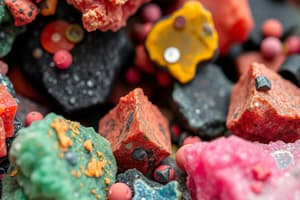Podcast
Questions and Answers
Which material was used to prepare the porous activated carbon for supercapacitor application?
Which material was used to prepare the porous activated carbon for supercapacitor application?
- Expired white chickpeas (correct)
- Expired black chickpeas
- Expired lentils
- Expired kidney beans
What was the activation agent used in the preparation of the porous activated carbon?
What was the activation agent used in the preparation of the porous activated carbon?
- Zinc chloride (correct)
- Sodium chloride
- Potassium chloride
- Calcium chloride
What was the process used to prepare the porous activated carbon?
What was the process used to prepare the porous activated carbon?
- Direct carbonization and reduction
- Direct carbonization and polymerization
- Direct carbonization and oxidation
- Direct carbonization and activation (correct)
What were the structural, morphological, and electrochemical studies focused on?
What were the structural, morphological, and electrochemical studies focused on?
Which university was the corresponding author affiliated with?
Which university was the corresponding author affiliated with?
What type of energy storage is the article focused on?
What type of energy storage is the article focused on?
What was the main objective of the study?
What was the main objective of the study?
What was the activation agent used in the preparation of the porous activated carbon?
What was the activation agent used in the preparation of the porous activated carbon?
What university was the corresponding author affiliated with?
What university was the corresponding author affiliated with?
What was the process used to prepare the porous activated carbon?
What was the process used to prepare the porous activated carbon?
Flashcards are hidden until you start studying




